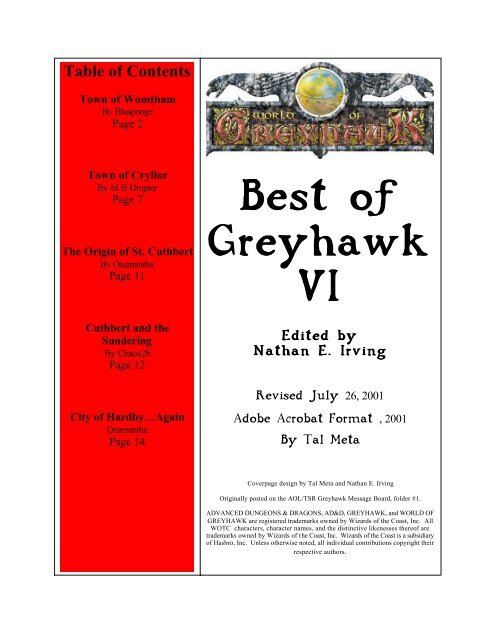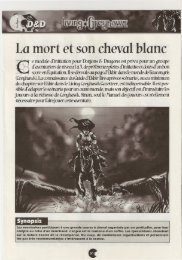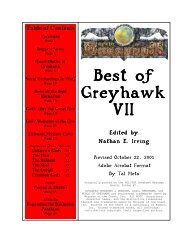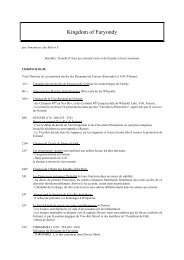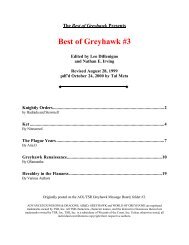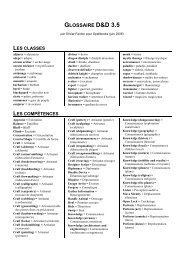You also want an ePaper? Increase the reach of your titles
YUMPU automatically turns print PDFs into web optimized ePapers that Google loves.
Mord. However, there is a vocal population <strong>of</strong>practitioners living in Womtham, among them a fewdefecting sorcerers from Aerdi. These citizens havegravitated to locales <strong>of</strong> common interest and there istalk <strong>of</strong> an actual organized guild being created. Anytruth to this rumor is yet unfounded, and no guildconstitution has yet been submitted to the towngovernment.City Layout:The Gatehouses: Womtham has four manygates. These are: Layman's Gate (leads into theEveryman District) The White Gate (leading into theCommoners and Mercantile Districts) The DuntideGate (westernmost gate from the Port District) TheLastsun Gate (easternmost gate from the Port District)The Outer City: Thaxx Keep on the outskirts <strong>of</strong>Womtham, even beyond the shanty towns, sits ThaxxKeep. It houses some small regiments <strong>of</strong> Nyrondesesoldiers, war strategists, and even a small contingent <strong>of</strong>knights. Patrols can be seen riding out every morningto patrol the roads, plains, and waterways. In the earlyevenings, soldiers head into Womtham for a bit <strong>of</strong>escapism. The war has been hard for most <strong>of</strong> thesepeople, and though the Treaty <strong>of</strong> <strong>Greyhawk</strong> has beensigned and sealed, the skirmishes from invaders fromthe east and south seem far from over. In truth, theWomtham post is a comfortable assignment, as it liessome distance from any <strong>of</strong> the imposed borders. Evenso, the warriors <strong>of</strong> the Citadel maintain a militantstance, quick to respond to any intrusion. The Citadelis helmed by the efforts <strong>of</strong> Captain Gregael Hoersmil.He is the commanding <strong>of</strong>ficer <strong>of</strong> the regiments there.Only the knightly order has rank equal to his. Theknights <strong>of</strong> Thaxx Keep are commanded by Sir CalburtRutherfal. The two commanding <strong>of</strong>ficers respect eachothers command, though they see very differently onmany issues. They are not so petty as not to realizethat they must work together for the good <strong>of</strong> Nyrondand King Archebold.The Port District: Built up in the gap <strong>of</strong>shoreline along the Duntide river, the Seaport districtlies beyond the protection <strong>of</strong> the town walls. Thepopulation is made up mainly <strong>of</strong> fishermen, cargo shipcrews, and boatwrights. There is a great deal <strong>of</strong> trafficon the Duntide today, and this portion <strong>of</strong> the townpr<strong>of</strong>its most from that. Womtham's port is seeinguntold growth and expansion, which keeps carpentersand laborers at work building docks, and the inn andtavern industry has likewise boomed to keep up withthe money these people are quick to spend on suchfrivolities. The buildings <strong>of</strong> the port district are mostlywooden, though a few stone founded constructions canbe found. The largest buildings here are theShipwrights and the Porters Guild Headquarters, whichare quickly becoming the most pr<strong>of</strong>itable companies inWomtham with the completion <strong>of</strong> the town walls.The Shanty Towns: However, though the warhas brought Womtham a rise in status and importance,it has brought the town its share <strong>of</strong> problems as well.With the fall <strong>of</strong> the Aerdi and the constant raids on theeastern fringes by humanoids from the Bone March,refugees and civilians have flocked to the protection <strong>of</strong>its newly erected walls. There, they had hoped torebuild their lives, only to have these hopes crushedwhen Duke Boomgren closed the gates to thesenewcomers. As such, an immense sea <strong>of</strong> tents, shacks,and covered wagons have congregated around thesouthern and western gates. These shanty towns arerife with those who have lost everything, and havebecome a haven for thieves and other fringe elements<strong>of</strong> Womtham. The nights are lighted by the greasysmoke from countless fires. With all the dangers theseshanty towns present, it is no wonder that so many stillwould prefer the dirty back alleys <strong>of</strong> the walledcommunity then their hovels, and with the constanttraffic <strong>of</strong> trade goods coming and going from thesegates, it is difficult to stem the trickle <strong>of</strong> these peoplewho make their way into the city. It is even said thatBenjamin's Hand, the local Aquisitioners Guild, hasmade a pr<strong>of</strong>itable business <strong>of</strong> bringing these peopleinto the town, whether by concealing them in carts orentering caravans, or by routes through the sewers,which empty out in reservoirs beyond the city walls.Duke Boomgren knows that the town economy cannotwithstand the population boom these poor soulsrepresent, and thus in an attempt to stop the trickle, hehas ordered the city watch posts to increase the shiftsand manpower at these gates to keep the newcomersout. This does little to stop Benjamin's business, andhas little effect on truly dedicated souls. In fact, it onlyenforces the hostilities between the townsfolk and theirnew neighbors, which is quickly turning Womthaminto a pressure-cooker <strong>of</strong> violence. To make mattersworse, the city guard is not sanctioned to enforce thelaw beyond the city gates. Benjamin has taken thisopportunity to heart, and his men are now the only lawthese shanty towns know. Through extortion and fear,the Aquisitioners Guild grows richer through the plight<strong>of</strong> these people. But all is not bleak. A few kindersouls have done much to ease the suffering <strong>of</strong> thenewcomers. A few makeshift churches and templeshave been constructed here and <strong>of</strong>fer shelter and goodfood to the people. The lines for soup kitchens onFreeday and long and twisted. A few other merchantsfrom within the city have found it pr<strong>of</strong>itable to findlaborers from within the ranks <strong>of</strong> the newcomers.Since they are not citizens <strong>of</strong> Womtham, they are notsubject to Guild control. This leads to more hostilitybetween the civilians and the shanty town folk.
The Inner City: With the construction <strong>of</strong> thewalls, the inner city has become divided into fivedistinct areas.The Commoners District (Thieves' Haven):Located on the Northeastern end <strong>of</strong> Womtham, theCommoners district is made up <strong>of</strong> lower classresidentials and slums. It is wrought with street gangsand thieves, though one will not find many beggarshere. Most <strong>of</strong> the population are laborers who workeither beyond the city or sell small crafts and wares inthe Mercantile district. Many <strong>of</strong> the buildings here arein horrible shape, primarily those farthest from thegates to the innermost portions <strong>of</strong> the city. While thecity watch maintains a strong presence along the walls,they are rarely seem in the innermost parts <strong>of</strong> thisdistrict, earning it the name Thieves' Haven by most <strong>of</strong>the townsfolk. A problem that has begun to intensify isthe hostility between members <strong>of</strong> the AquisitionersGuild and a lowly, and yet unsanctioned, thievingcompany led by a shrewd man named Temmick.There are also the activities <strong>of</strong> the Red Cloth, alongtime street gang that has been linked with manydisappearances and violent acts, adding to the growingchaos <strong>of</strong> this place. Another problem brewing in thisdistrict are the rising population <strong>of</strong> refugees and shantytown folk, secreted in by Benjamin's people. There aredefinite hostilities and competition between them andthe citizenry which regularly leads to violence in theback alleys and dirty streets <strong>of</strong> Thieves' Haven.The Mercantile District: This is the sight <strong>of</strong>the majority <strong>of</strong> the business holdings <strong>of</strong> Womtham.Even in the earliest and latest hours, people from allwalks <strong>of</strong> life can be found here. Beggars and laborerswalk side by side with noble merchants and craftsmenwho work in this area. The City watch maintains agreat presence here; in these days perhaps greater thanany other part <strong>of</strong> the town. Nearly anything can bebought and sold in this district, and small stands andstreet performers litter the wider streets here. Many <strong>of</strong>the town's guilds maintain <strong>of</strong>fices and warehouses inthis district. The temple <strong>of</strong> Zilchus is a gloriousbuilding which shines like a gold coin on the darknights in this district.The Everyman District: This district is largelycomposed <strong>of</strong> residences from the lower and middleclasses. Away from the busiest streets, this districtretains a quiet composure, though the folk do gather intaphouses in the evening to grumble about the shantytown folk and the iron hand <strong>of</strong> Duke Boomgren'smartial decree. These are not a vocal folk. They workhard for what they earn and strive to be more than theyare. The constant reminder <strong>of</strong> squalor lies just beyondthe Layman's Gate in the shanty town which has grownaround it. The city watch and militia maintain somepresence here, but most <strong>of</strong> their efforts lie along thegatehouse and battlements as they attempt to quell thetide <strong>of</strong> refugees building up against the walls. Thereare no guild <strong>of</strong>fices in the Everyman District, but a few<strong>of</strong> the lower <strong>of</strong>ficers <strong>of</strong> many guilds make their homeshere. There are also a few churches and temples whichare located here.The Town Proper: In this district can be foundmany <strong>of</strong> the guild headquarters and political buildingsupon which control <strong>of</strong> the city hinges. It is also thesite <strong>of</strong> some businesses. The city watch commands astrong presence here, but the militia is nearly absent.There are a few residences, but town building codesdiscourage the presence <strong>of</strong> such. Besides thegovernment buildings, the Town Proper is mostassociated with the large temples which are locatedhere. The majority <strong>of</strong> faiths worshipped in this regioncan be found here, and many compete with one anotherfor fellowship. Town codes prevent any temple orchurch from being located within two blocks <strong>of</strong>another, which does much to prevent any conflictsbetween faiths. Since the wars, most <strong>of</strong> the clergieskeep to themselves except on Freeday mornings, wherepriests <strong>of</strong> every color can be seen attracting theattention <strong>of</strong> potential followers. Some merchantscompare this practice to the frequent auctions held inthe Mercantile District.The High Quarter (Burghers' Way): This isthe aristocratic den <strong>of</strong> Womtham. It is home to manymiddle and upper class citizens, many <strong>of</strong> whom areguild <strong>of</strong>ficers, pr<strong>of</strong>essional tradesmen, politicians, andvisiting nobility. There are a few inns here, and theyare the ritziest that Womtham has to <strong>of</strong>fer. Businessesare few, and those that are here are highly specialized.This district has close ties to the Town Proper. It isclean and well patrolled by the City Watch. A few <strong>of</strong>the larger estates employ independent security forces,but these are the obvious minority. Most <strong>of</strong> the people<strong>of</strong> the High Quarter have gone to pains to isolatethemselves from the horrors <strong>of</strong> war torn Nyrond, andin the chaos <strong>of</strong> the wars, many lost their fortunes.Thus some estates are still vacant today.Important Locations:The Aquisitioners Guild (Benjamin's Hand), Location:Town Proper. The Aquisitioners Guild was founded innearly seventy-five years ago in the midst <strong>of</strong>Womtham's infancy. It was originally conceived as afencing organization. This business proved quitepr<strong>of</strong>itable. Benjamin Ullber took the reigns <strong>of</strong> theorganization only a decade ago, and began anaggressive program <strong>of</strong> progression. Now theorganization is literally a den <strong>of</strong> thieves, though
sophisticated ones. They do not go out and pickpockets or perform petty crimes, but are ratherinvolved in larceny, blackmail, and public security.The latter aspect has found its niche in the shantytowns around the town gates. Benjamin Ullber hasbecome a very rich man, and enjoys a great amount <strong>of</strong>loyalty from his men (something which sets theAquisitioners Guild apart from the standard thievesguild). He surrounds hims elf with his "palm," a body<strong>of</strong> six <strong>of</strong> his most trusted people. The rest are referredto as his hand, lending to the popular joke thatBenjamin has his fingers in everyone's' pie.Royal Mint, Location: Town Proper. This is only one<strong>of</strong> the three royal mints <strong>of</strong> Nyrond. It is located byitself on a single city block in the town proper. Theentrance is marked with the monstrous seal <strong>of</strong> theArchebold family inset with gold. The building itselfis built <strong>of</strong> stone and marble, making it one <strong>of</strong>Womtham's most noted buildings, next to the Duke'sown palace, <strong>of</strong> course. Shipments leave for Rel Mordin staggered intervals. Shipments are usually splitbetween water and ground shipping and are alwaysaccompanied by a contingent <strong>of</strong> armed guards.Mercenaries are never hired to guard thesetrains as the shipments are far too important to Nyrondthese days. Despite the heavy guard duty on theseshipments, they rarely go unaccousted in their journeyto Rel Mord. Now, with so people from the old banditkingdoms roaming the plains <strong>of</strong> Nyrond, travel hasbecome exceptionally hazardous. Duke Boomgren andhis cabinet support the use <strong>of</strong> decoy shipments to drawout these bandits in hopes <strong>of</strong> striking them down.Current Events, Martial Law:With the evergrowning discord surroundingthe outer shanty towns, Duke Boomgren imposedmartial law on Womtham. Curfews have beenimposed in all districts but the Mercantile, and themilitia has been called out to assist the city watch inenforcing the town codes. Most <strong>of</strong> the citizenry dislikethis control and mutter that, with the war over, theDuke has no one to battle but his own people. Mostalso blame the current state on the shanty town folk.Rats in the Sewers: There have always been wereratsin the sewers <strong>of</strong> Womtham, but these creatures havebecome increasingly bold in the months prior to thewar's end. It is said in some circles that they are beingled by a particularly vicious, red furred priest <strong>of</strong>Squerrik who favors human sacrifice in rituals to thevile rat god. Even more speculation has arisen aboutthe relationship between Benjamin's Hand and thewererats. The Hand's use <strong>of</strong> the sewers to smugglerefugees is quite conspicuous considering the recentviciousness <strong>of</strong> its other denizens.Womtham NotesIn response to Sobhrach's questions:1) Duke Boomgren is one <strong>of</strong> the more loyal <strong>of</strong> theKing's men. He has little reason to be otherwise solong as business is good. However, he is frustratedabout the current situation which has, quite literally,popped up under his nose. Womtham doesn't have themoney or the real man power to deal with the surge <strong>of</strong>refugees and as much as the Duke would like, theredoesn't appear to be any aid coming from Rel Mordany time soon. So while Boomgren my be a loyalretainer, his loyalty is surely being taxed.2) There isn't an organized temple to either <strong>of</strong> thosegods. But now, with the current situations present inWomtham, one might just be erected. I would have tosay that if one was, it would have the following scores(Location: Mercantile, Size: 3, Acceptance: 6). As faras the church <strong>of</strong> Hextor goes, you have to rememberthe current climate in Nyrond. Hextor's clergy is notthe largest or most accepted in Womtham, but somefolk do frequent there to pray for the god'sappeasement. Also, there are some battle hungry folkthat pray to Hextor to bring their enemies down. Lots<strong>of</strong> people in Nyrond have lost their lands, fortunes, andeven families over the course <strong>of</strong> the war, and there issome definite bitterness to be found among them.3) This branch <strong>of</strong> the Royal Mint has long been locatedin Womtham, most likely to take advantage <strong>of</strong> thenearby mines in the Flinty Hills. I seriously doubt theKing would have sanctioned the construction <strong>of</strong> a newmint during the wars. However, if you really want t<strong>of</strong>ollow the tangent you started, consider that DukeBoomgren is part <strong>of</strong> the Archbold bloodline (not to<strong>of</strong>arfetched), say distant cousins. Boomgren's familyhas been in charge <strong>of</strong> Womtham for severalgenerations and it is not unlikely that this mint wasbuilt in Womtham as a sign <strong>of</strong> favor to the Boomgrenfamily, perhaps around 25 years ago (just a wildguess).4) The soldiers <strong>of</strong> Thaxx Keep have no connection tothe Duke other than their proximity. The higher<strong>of</strong>ficers (Sir Rutherfal et al) don't wish to anger theDuke for fear that he would shut them out <strong>of</strong>Womtham with the rest <strong>of</strong> the refugees, thus leading toserious moral problems with the soldiers (Friday nightand nothing to do....). It is very possible that either theKnight Commander on the Regiment captain couldharbor their own doubts about Archbold (however, theKnight would be less likely to act on such matters).This should be up to for the DM to decide, however.
5) Not really. Womtham is far enough away to bebeyond the concerns <strong>of</strong> Aerdi. In addition, the GreatKingdom is in such chaos now that it would bedangerous to risk communication efforts. However,were the High Priest <strong>of</strong> Zilchus's Aerdi chapter to visitWomtham, the clergy in the Mercantile district wouldwant to be the first to know.6) I know! It makes for a great alternative to thestandard dungeon crawl or the dreaded "stand-<strong>of</strong>f atthe border" scenario which has cast such a darkshadow on FtA.Hope this answers your questions, Tom.Womtham ConclusionWell now that everyone is back andaccounted for, maybe we'll see some more action onthis board. Its been a bit slow with all you GenCongroupies out and about. At least QSam thought towrite us and let us know what a good time we missed.:P Oh well, maybe next year.omtham has proven a good adventure site.My players just completed an interesting jaunt in theFlinty Hills on a mission from Duke Boomgren to finda new home for the shanty town folk. They sought outthe gnome host <strong>of</strong> the Hold <strong>of</strong> Coldrock and latertraveled to the goblin infested halls <strong>of</strong> StonegrindTower. No, no goblin slaughtering for these guys -they had bigger fish to fry. The tormented assassin,Grael Allyster, serving his penance in isolation forkilling his beloved in a fit <strong>of</strong> rage after finding out thatsee and Benjamin (yes, that Benjamin) had laintogether, proved a fun not so villainous opponent. Butnow he is dead and the new community <strong>of</strong> Stonegrindis rising where he fell. Together with the humanrabble <strong>of</strong> Womtham and other neighboringcommunities, the dwarven people <strong>of</strong> that place havereturned to take it to new heights. Now the spirits <strong>of</strong>the old dezidens can rest and their spirits can leave themines beneath the tower.Just one more step on a long road torenaissance. Next stop: Verbobonc. Only Istus knowswhat fun we'll find there. Just thought I'd leteverybody know. :)
The town is located on a bend <strong>of</strong> the JavanRiver where the Crystal Run flows into the larger river.Outside the town is an extensive dock area, alwayscrammed with river traders. The town within isdivided into several sections, the largest <strong>of</strong> which is theCommercial Quarter on the west. Below that, andacross the Beggars Canal is the Thieves' Quarter.Redmont Canal separates the Commercial Quarterfrom the Old City, where will be found the Plaza <strong>of</strong>Justice, the Temple <strong>of</strong> Pholtus, the Magic Quarter, andthe Mount <strong>of</strong> the Stars. Further east, across MollyCanal, is upper and lower Halfling Town. HalflingTown abuts the great Castle <strong>of</strong> the Count <strong>of</strong> Cryllor,which guards the town from the east. To the north,outside the town proper, is a slum area that is mostlyhome to vagabonds, lunatics, and diseased beggars.Next time, we'll go on a brief tour <strong>of</strong> theCommercial Quarter, touching Armory Square andArmory Row, the streets <strong>of</strong> the moneychangers, theTradeway, and Fharlanghn's Square. Then, insubsequent postings, we'll hit the Thieves' Quarter, theOld City, Halfling Town, and the outer town.Cryllor: Market SquareMountain Road Gate on the west opensdirectly onto the Grain Market. The Grain Market isheld in a roughly triangular courtyard with a number <strong>of</strong>streets running <strong>of</strong>f <strong>of</strong> it. To the north are the towngranaries, while a large, abandoned tower known asthe Barbican looms to the south, beyond which can befound the temple <strong>of</strong> Tritherion in Armory Square,which opens the way to Smithy Lane, Gemners Row,and the famous Armory Way. Further south, followingthe path <strong>of</strong> the canal which separates the CommercialQuarter from the Thieves Quarter, is the Tradeway.Directly east <strong>of</strong> the Grain Market will befound the busy streets where the money changersconduct their businesses, located nearby the publicscales, the Barracks, and the Grand Temple <strong>of</strong> Zilchus.The streets then continue on through the heart <strong>of</strong> theFair districts and eventually over the canal into the OldTown.Market Square itself is always a bright andbusy place, filled with carts <strong>of</strong> fruit, vegetables, andgrains from local farmers. Astute reeves barter withsharp-tongued goodwives or the servants <strong>of</strong> local lordswho come to replenish supplies for their manors.Meanwhile, the wine criers work this section <strong>of</strong>Cryllor thoroughly, <strong>of</strong>fering samples drawn from thevarious inns and taverns. There will also be beggarsseen crowding the gates, calling for alms but alsooccasionally selling information to those with therequisite silver to pay.The Square boasts at least three quality inns--the Black Horse, the Lion Rampant, and the Griffon'sRoost. The Lion Rampant is sometimes called theKing's Inn, since the sign displays the Keoish lion on ared field. Typically, the inns host merchants fromIstiven and Gorna, but currently the Griffon's Roost ishome to a band <strong>of</strong> mercenaries from Gran March, ledby one Qronos, looking for employment and, failingthat, trouble. They are being watched carefully by theGuard Captain Guilloches, who was apparently oncean associate <strong>of</strong> Qronos.The only other places <strong>of</strong> note in the Squareare the Barbican and the shop <strong>of</strong> Rus and Korbo theOutfitters. The Barbican, as has been noted, was oncea watchtower but is now largely a ruin, and onlyravens perch atop its crumbling walls. The folk <strong>of</strong>Cryllor avoid the place at night, as it is rumored to behaunted. The shop <strong>of</strong> Rus and Korbo is strategicallylocated so as to pr<strong>of</strong>it from the business <strong>of</strong> thosewishing to make a foray into the mountain regions.Maps are available, as well all sorts <strong>of</strong> supplies formountaineering, and even guides. As we leave MarketSquare on the little street leading south past theBarbican, we will come upon Armory Square.Cryllor: Armory SquareArmory Square is usually packed withmercenaries <strong>of</strong> all varieties--dwarves from the Jotensand the Crystalmists, gnomes from the Good Hills andStark Mounds, sturdy pikemen and archers fromGe<strong>of</strong>f, the taciturn knights <strong>of</strong> Sterich, and tall,mustachioed warriors from the Yeomanry.Dominating the scene is the temple <strong>of</strong>Tritherion; the dark blue and purple-clad priests <strong>of</strong> theSummoner will be found throughout this area, mixingwith the blacksmiths, armorers, and common soldiersthat are to be found in numbers here. There is sometension between the soldiers who hold Tritherion astheir patron and those who follow the ways <strong>of</strong>Kelanen. Members <strong>of</strong> the town guard have been toldto keep an eye on this area, but many <strong>of</strong> them arethemselves members <strong>of</strong>, or sympathetic to, theCoalition <strong>of</strong> the Summoner (as is His Grace, the Count<strong>of</strong> Cryllor himself).Directly across from the temple <strong>of</strong> Tritherionis the Hound and the Falcon, named after two <strong>of</strong>Tritherion's summoned beasts. Needless to say, it ispopular with the soldiers and smiths in the area.There are three streets leading <strong>of</strong>f ArmorySquare; the westernmost street, which follows the line<strong>of</strong> the outer wall, is home to the local blacksmiths, themiddle street is the famous Armory Way, which curvesalong until it intersects with the street <strong>of</strong> thegoldsmiths, and the last is Gemners Row, which windsalong for some way before it opens onto the Tradeway.The street <strong>of</strong> the Blacksmiths isunremarkable, save for a small shrine to Blereddlocated there. On Armory Way, the visitor willencounter many adventurers, knights, and soldiers who
have business with the shieldmakers, helmetmakers,swordsmiths, and armorers who pursue their craft onthis street. The most famous <strong>of</strong> the armorers is Hrolfthe Burly; Hrolf is said to have studied with thedwarves, from whom he has derived both his techniqueand his personality. He is fond <strong>of</strong> games and brew,and will <strong>of</strong>ten be seen drinking with 1-3 dwarves at theBlue Boar on Gemners Row, preferring that place tothe more nearby Green Griffon on Armory Way. TheGreen Griffon itself is popular with soldiers, which isthe current home <strong>of</strong> the half-elf Ikklarion, who hiresout as a guide to the mountain regions, Finn the Lucky,a bard from Ge<strong>of</strong>f and sole survivor <strong>of</strong> an ill-fatedmission to one <strong>of</strong> the fallen dwarf holds in themountains, and the mercenary Claritta, a tough fighterfrom Hardby and her band <strong>of</strong> women mercenaries.Gemners Row, as noted, is the location <strong>of</strong> theBlue Boar tavern. Other places <strong>of</strong> note include theshop <strong>of</strong> Tubal the Gemner; Tubal is one <strong>of</strong> thewealthiest gemners in Cryllor, partly due to his closeassociation with the gnomes <strong>of</strong> Clan Gilgarney. Infact, his daughter Verene is now studying illusionmagic with Old X'ssi <strong>of</strong> Gilgarney, a masterfighter/illusionist and trainer <strong>of</strong> many other gnomishillusionists, including the infamous thief known asGnomenclature, who is wanted in Ge<strong>of</strong>f, Sterich, theYeomanry, and Keoland, and is now believed to beliving somewhere on the Wild Coast. Gideon theMage also makes his home on Gemners Row; he is themost gregarious <strong>of</strong> Cryllor's mages, and most willingto employ a party <strong>of</strong> adventurers on some apparentlytrivial or whimsical errand which will later turn out tobe fraught with peril.Next time, we will proceed along theTradeway, and then back up to the streets <strong>of</strong> Cryllor'smoneychangers and, if time permits, Fharlanghn'sSquare.Cryllor: The TradewayWell, back to Cryllor at last. We havealready had a brief overview <strong>of</strong> the town, and a visit toArmory Square and Armory Way. Now, as weproceed on Armory Way, take a small detour ontoGoldcasters Lane, and turn left (east) onto the broadavenue that parallels the Lower Walk which followsRedmont Canal, we are on the Tradeway.As the name implies, the Tradeway is one <strong>of</strong>the most impressive streets <strong>of</strong> Cryllor during the Fairseason, at which time it is crowded with demi-humantraders and tinkers <strong>of</strong> all varieties. For that reason, it isalso a favorite training ground for apprentice thieves,and visiting adventurers must be wary <strong>of</strong> their purses.Some <strong>of</strong> the more celebrated inns <strong>of</strong> the Tradewayinclude the Dancing Devil, the Golden Sheaf, theJourneyman, and the Beaming Banshee. The DancingDevil is run by a burly giant <strong>of</strong> a man who goes by theun-<strong>Greyhawk</strong>ian name <strong>of</strong> Halfdane and features exoticdancers and equally exotic fare. Halfdane also <strong>of</strong>fersspecial customers the chance to wrestle with owlbears(he has two gigantic owlbears who guard the premisesat night) and can supposedly procure such beasts asunicorns and faerie dragons to those willing to pay theprice. All <strong>of</strong> this, <strong>of</strong> course, is strictly illegal, but sinceHalfdane is a personal friend <strong>of</strong> the guard captainGuilloches, nothing much is done about it.The Golden Sheaf caters to those halflingswho are not staying in Halfling Town; the owner, oneBirkby Glynwickham, maintains a staff <strong>of</strong> halflingcooks, servers, and stable hands. One human scullion,Jaspar, a sullen and resentful young thief, is actually amember <strong>of</strong> the Cult <strong>of</strong> Erythnul, reporting likelyprospects for robbery and murder to the brigand chiefHryk at the Crossed Daggers (in the Thieves Quarter).The Journeyman is run by Tolug Ruun, aretired adventurer from the Dreadwood region, and is afavorite among rangers, druids, and even elves fromthat area. Tolug has proclaimed every Freeday halflingnight at the Journeyman (an attempt to bring incustomers from the Golden Sheaf). Halflings and theirguests eat for free (although they must pay for theirown drinks).Finally, the Beaming Banshee is recognizableby the sign depicting a banshee with a mug <strong>of</strong> aleclasped in her hand and a bright smile on her face.The ale really is that good, thanks to the three gnomeswho brew the stuff for Torvald the Helm, theproprietor. Torvold is an ex-soldier from Sterich, andall four are accomplished thieves and bandits who firstmet in the Stark Mounds. Now they act as fences andadvisors for the rest <strong>of</strong> the group which preys on thoseusing the road between Cryllor and Flen.It is sometimes difficult for customers to getto the inns <strong>of</strong> the Tradeway without getting mobbed bythe numerous traders who crowd the street outside theinns during the Fair. There are very strict lawsprohibiting foreign merchants from thus assaultingpotential customers, but in the confusion <strong>of</strong> the Fair,these laws are <strong>of</strong>ten neglected. Among the otherpermanent residents are several wealthy merchants andmoney lenders. At the eastern end <strong>of</strong> the street is abridge leading across Bollo's Canal and into the lowersection <strong>of</strong> Old Town, where will be found the Keep,the Hall <strong>of</strong> Justice, and the villas <strong>of</strong> the pettyaristocrats.We won't be going over into Old Town justyet. Instead, we will head back up to the streets <strong>of</strong> themoneychangers, by way <strong>of</strong> Saddlers Row, crossing thestreet <strong>of</strong> the gemners on the way. On the way up, youwill see the most magnificent saddles displayedoutside the shops, as well as fine scabbards, belts, andpurses as well.
Cryllor: Money ChangersThese streets are <strong>of</strong>ten crowded withforeigners looking to trade their own currency for coin<strong>of</strong> the realm. One will find an abundance <strong>of</strong> dwarvesand gnomes, as well as humans from the states to thewest. The street is well-patrolled.Ubu is the most prominent <strong>of</strong> the localmoneychangers, a shrewd investor and a good man <strong>of</strong>business. Portly and jovial, Ubu appears slow andabsent-minded, but this is a front. There is actuallyprecious little in Cryllor or the larger realm that he hasnot heard about. It is not generally known that he is aservant <strong>of</strong> Circle <strong>of</strong> Eight, possibly <strong>of</strong> Mordenkainen.As a man <strong>of</strong> business, he is truly neutral, but he willalso act as an unseen sponsor <strong>of</strong> parties who are(wittingly or unwittingly) servants <strong>of</strong> the Balance.Another <strong>of</strong> Cryllor's wealthy moneychangersis Cobarro, a merchant formerly <strong>of</strong> Monmurg but nowin exile from his home in the Hold <strong>of</strong> the Sea Princesdue to his secret opposition to the slavers who operatethere. That story, widely known in Cryllor, is afabrication, <strong>of</strong> course. Cobarro is a spy for the Prince<strong>of</strong> Toli, one <strong>of</strong> the best. He stays in Cryllor to workagainst the Coalition <strong>of</strong> the Summoner. MostlyCobarro gathers information, but when direct action iscalled for, he generally employs the assassin Hryk,with whom he meets on *very* rare occasions at theCrossed Daggers. Normally, Cobarro frequents theGreen Griffon and the Griffon's Roost, and othertaverns favored by mercenaries, from whom he hopesto hear more about the movements <strong>of</strong> the devotees <strong>of</strong>Trithereon.There are several inns around the area, as it iswidely known as a fairly safe place to stay. The best isthe Golden Orb, favored by the wealthiest visitingmerchants. Sometimes, the minstrel Jounie will befound here, with rumors and stories from the StarkMounds, the Oytwood, the Hornwood, and the LittleHills.Nearby these <strong>of</strong>fices and inns are the guardquarters and the public scales. The mercenary captainGuilloches may be found here. Guilloches is also thelieutenant <strong>of</strong> the Fair, under the command <strong>of</strong> Cassius,and in the pocket <strong>of</strong> the Thieves Guild. Guilloches'former companion and hated rival Qronos would behappy to work with anyone to prove Guilloches'connection with the Guild (see the Griffon's Roost,detailed earlier).Finally, there is the impressive temple <strong>of</strong>Zilchus just to the south <strong>of</strong> the streets <strong>of</strong> themoneychangers. The temple is overseen by the HighPriestess Xithra and her six assistants. The blue-greenrobed priests <strong>of</strong> this deity will <strong>of</strong>ten be found mixingwith the important merchants <strong>of</strong> Cryllor.Next time, we will stroll up to the GrandWay, just north <strong>of</strong> these streets, and walk east in thedirection <strong>of</strong> Old Town. Before we cross Bollo's Canal,however, we will have a chance to jog northward upthe Crossway to the Square <strong>of</strong> Fharlanghn, after whichwe will head north along Canal Street and acrossBollo's Canal into the northern section <strong>of</strong> Old Town,up the Mount <strong>of</strong> Stars to pay homage to Fharlanghn'smystical brother Celestian.Until then, good journeys.
The Origin <strong>of</strong> St.Cuthbertby QSamanthaWell, well, well if it isn't that noted lurker Iquander,known for complaining about how others don't postvery <strong>of</strong>ten.;) Good thing for you that you knewenough to leave a trail <strong>of</strong> breadcrumbs and no littlebirds got you lost. You might have ended up inShadowdale!You asked about St. Cuthbert so here goes.The following account, in much expandedform, is contained in the Omnivall, the holy book <strong>of</strong>the Pholtic Church and reflects a Pholtic world view.However, this account should be given significantcredence because it is in substantial agreement with theCuoberiam, the Cuthbernian holy book.In the beginning, there was only light anddarkness, mingling without pattern. When the lightseparated from the darkness, the first deities came intobeing, Nerull, Bringer <strong>of</strong> Darkness and Pelor, theCreator. These gods were not those <strong>of</strong> the same nameswe know today, though they would become so in time.In the beginning, they were beings <strong>of</strong> such immensebut simple power that they were effectively nonsentient.In the act <strong>of</strong> defining their separateexistence's, Nerull and Pelor created the universe,drawing order from the primal chaos.Among the first deities created were thesisters Beory, the Oerth Mother, who oversaw thecreation <strong>of</strong> Oerth, and Istus, The Lady <strong>of</strong> Fate. Beorywas born <strong>of</strong> Pelor. Istus was born <strong>of</strong> Pelor and Nerull,becoming the Colorless and the AllColored to theirwhite and black. When Istus took form from Nerulland Pelor, she diminished them both and they becamethe gods we now know, attaining sentience for the firsttime, as their minds cleared, no longer overwhelmedby their own immensity.In time, Istus and Pelor the Lesser gave birthto Pholtus, Lord <strong>of</strong> Light and Law.In the early days <strong>of</strong> Oerth, when upstart manhad learned the use <strong>of</strong> fire to forge metal and workwood into wheeled conveyances, pulled by horses hehad tamed, Pholtus' avatar walked the land and taughtmen laws that they might govern themselves andmaintain the progress <strong>of</strong> their civilization. To aid himin his efforts, the Light Bearer chose from among hisfollowers those who most closely approached hisideals and raised them up as his saints. The first manraised up was named Cuthbert.Saint Cuthbert threw himself into his assignedtask with dedication and zeal. So great was theimpression that he made upon the mind <strong>of</strong> men withwhom he came in contact that many worshipped himas an intercessor with Pholtus, who was <strong>of</strong>ten moreinflexible than Saint Cuthbert. So long as SaintCuthbert remained an intercessor and not anindependent object <strong>of</strong> worship, Pholtus was content forhe grew in power for having saints subordinate to him.But all was not well within the Church. St.Cuthbert, try as he might, could not accept that Pholtusallowed all those <strong>of</strong> lawful alignment to worship him,even raising up lawful good, lawful neutral and lawfulevil saints. Unable to accept the creation <strong>of</strong> lawful evilsaints, St. Cuthbert rose up against his god.The Origin <strong>of</strong> St. Cuthbert 2Rallying those who worshipped Pholtusthrough him, St. Cuthbert denounced his maker and thefolly <strong>of</strong> evil. Law, St. Cuthbert preached, must serve agood end or it is better to have no law at all for evillaws use law as but an excuse to legitimate evil.Pholtus in his desire for law failed to see that he was infact championing evil.For his part, Pholtus grew furious that hewould be declared a champion <strong>of</strong> evil! He representedlaw and only law, in all its forms.Thus, was the doctrinal breach andconsequent enmity that still characterizes relationsbetween the Pholtic and Cuthbernian Churches born.When Pholtus sought to smite his waywardsaint, Rao, the God <strong>of</strong> Reason, interceded. Seeing thereason in St. Cuthbert's position that laws must begood and recognizing in St. Cuthbert a useful servantwho could act to preserve the peace, Rao raised St.Cuthbert up as an intermediate god <strong>of</strong> wisdom on a parwith Pholtus and charged him with service. Thus,Cuthbert remains a saint, though a god. Where oncehe was the first Pholtic saint, he has become the firstRaoan saint.Because <strong>of</strong> Rao's pacifism, he prefers to giveSaint Cuthbert free reign to conduct his own affairsand does not demand that Cuthbert act as anintercessor for him. The relationship between the twodeities is that <strong>of</strong> mentor and student, whereasCuthbert's relationship with Pholtus was always that <strong>of</strong>the master and servant.The rivalry between the Cuthbernian andPholtic Churches is easy enough to understand andmore intense feelings lay hidden just below thesurface. The rivalry is definitely not friendly.Both St. Cuthbert and Pholtus continue thepractice <strong>of</strong> raising up mortals to sainthood. Eachchurch has a substantial number <strong>of</strong> saints that areworshipped as intercessors. However, the powers <strong>of</strong>these saints are much less than that originally bestowedon Cuthbert by Pholtus, lest a saint rebel in the future.Only the original Pholtic saints, created at the sametime as St. Cuthbert are <strong>of</strong> a more powerful variety.
Cuthbert and the Sunderingby Chaos28Thanks for asking. Here goes... The VERYun<strong>of</strong>ficial history <strong>of</strong> St. Cuthbert...It is written in the Book <strong>of</strong> Twelve Canticlesthat Cuthbert the man was made Beatus <strong>of</strong> the PholticChurch in the second decade <strong>of</strong> the Age <strong>of</strong> GreatSorrows. Cuthbert, by all accounts, was a priest <strong>of</strong>Pholtus and well-known for his avenging spirit and hislack <strong>of</strong> mercy when dealing with the unrepentant.Given his popular appeal, it seemed only fitting thatthe church should select him for Beatus, and thismotion was passed by the Council <strong>of</strong> Primates in whatis now known as the Theocracy <strong>of</strong> the Pale. Cuthbert'sicon was enshrined in towns and villages, and symbols<strong>of</strong> his icon were carried by those who followed hisparticular brand <strong>of</strong> Pholtic faith. This was all well andgood... for a time.As is the case with all great men, however,Cuthbert was destined to suffer ignominies at thehands <strong>of</strong> petty, but powerful men. Such was the casewhen Cuthbert attacked and killed a fellow priest <strong>of</strong>the Pholtic Church for acquiescing to slavery, apractice which was even then falling out <strong>of</strong> favor withthe common folk. The Pholtic church had two optionsat this point: to elevate Cuthbert for his forthrightness,or to decry his insubordination and fratricidal behavior.As several <strong>of</strong> the High Primates were slave-ownersthemselves, the church chose the latter path. Cuthbertwas imprisoned for his deeds. He languished in prisonfor ten long years until he was freed by a writ from one<strong>of</strong> the Primates who had followed his deeds andbelieved as Cuthbert did.Rather than become the right-hand man <strong>of</strong> hisliberator, as some thought he might, Cuthbert struckout for the west, fully intending to start his own Pholticorder in younger lands, where people might still besalvaged from the moral abuse <strong>of</strong> the Great Kingdom'staint. He landed in Furyondy, where he established asmall chapel which soon grew into a church, then intoa temple, then into a cathedral.The people <strong>of</strong> Furyondy were overawed bythis great orator and fiery priest, and his flock grewwith each passing year. So much so, in fact, that theCouncil <strong>of</strong> High Primates back in the Great Kingdomcould not help but take notice. Action was obviouslycalled for, and the church could not exactly mount awar just because a breakaway priest was becomingpopular in a foreign land. There were many thingsproposed, and what came out in the inner chambers,more than a decision regarding Beatus Cuthbert, was agrowing recognition <strong>of</strong> the gulf which separated theorders <strong>of</strong> the Pholtic Church. As the negotiations anddebates reached fever pitch, something terribleoccurred. One <strong>of</strong> the Pholtic priests was found slain inthe cloisters, a medallion <strong>of</strong> Beatus Cuthbert stilldangling from his strangled neck.The inner chambers <strong>of</strong> the Council <strong>of</strong> HighPrimates became a veritable war zone. Personalguards <strong>of</strong> one priest clashed with those <strong>of</strong> another,blood was spilled, and threats were made on families,congregations, and lands. Chaos ensued for severalnights. This became known as the "Schism <strong>of</strong>Humours" in Pholtic parlance, the time when(according to Pholtic doctrine) Pholtus chose to revealto his priests the many faces <strong>of</strong> law. The scene in theinner chambers was not pretty, and some doubt thatPholtus the god had anything to do with whattranspired.The outcome was that the newly mintedWhite Priests <strong>of</strong> Pholtus immediately retired to theirfortresses and sanctuaries and declared themselves thecenter <strong>of</strong> the church. Shortly thereafter, the so-calledBlack Priests did the same, adding theexcommunication <strong>of</strong> the White Order to their agenda.All the while, Cuthbert's congregation grew, withbarely a glance east toward the Great Kingdom.Cuthbert and the Sundering 2After some time, a bull arrived in Furyondyfrom the headquarters <strong>of</strong> the White Order, informingBeatus Cuthbert that he had been elevated to livingsainthood for his courage and forthright upholding <strong>of</strong>law in the holy name <strong>of</strong> Pholtus. He was required togather his temple guard and make his way immediatelyto the fortress in what is now known as the Theocracy<strong>of</strong> the Pale.Cuthbert was enraged. He tore the bull to bitsand flung the pieces into the fire (but not before itscontents had been read by no less than a dozenawestruck temple staff). Consulting with sages andwizards, Cuthbert set out from his temple, leaving it inthe capable hands <strong>of</strong> his staff. What filtered back tothe temple concerning Cuthbert's mysterious missionwas that he had learned that he could become a god inhis own right, through personal effort.It should be noted that Cuthbert was never aman <strong>of</strong> religion, exactly. He was a faithful man, but<strong>of</strong>ten out <strong>of</strong> his depth in council chambers and secretsessions. He was, it is said, easily confused by theguile <strong>of</strong> more powerful priests, and for this reason, hechose to avoid the politics <strong>of</strong> the church as much aspossible. This bull requiring him, in essence, to act asthe mascot <strong>of</strong> a political cause, however ecclesiasticaland righteous, was a tremendous slap in the face.Cuthbert vanished for many years, seeminglydisappearing from the face <strong>of</strong> Oerth.In his absence, his church grew terrifically inpower. Several prominent nobles and even royals
declared their faith in the newly minted Saint Cuthbert,and money flowed like water into the church c<strong>of</strong>fers.The temple became a cathedral, which became thekernel <strong>of</strong> the great basilica it is today.It is not known for certain what happened tothe saint in his travels, although apocryphal stories tell<strong>of</strong> mighty battles, trips into the Hells themselves, anddeeds so subtle and good that they were hardlyremarked on for years. What IS known is thatCuthbert eventually returned to his temple, now a busycathedral. And he did not come meekly.The temple records, if they are to be trusted,tell <strong>of</strong> the expense <strong>of</strong> repairs necessitated by the Saint'sreappearance. He tore down the symbols, destroyedthe holy services, and flung the contents <strong>of</strong> the <strong>of</strong>feringbox out into the gutters. Priests were driven out <strong>of</strong> thetemple along with the faithful, and Cuthbert sat in hisruined temple and brooded for days. No one would gonear him. The people began to speak in hushedwhispers about the nimbus <strong>of</strong> light which surroundedhim.Then, one day, a golden light seemed to pourout <strong>of</strong> the temple, and the faithful cautiouslyapproached the welcoming sight, albeit with a touch <strong>of</strong>terror. There were screams and gasps as the templedoors exploded outward, ripped <strong>of</strong>f their hinges byCuthbert himself, who stood in the archway. Hisnimbus outshone the noonday sun."I am Saint Cuthbert," he said, and his voicecarried the length <strong>of</strong> the city, reaching into homes,taverns, and even the prisons. "I am your god. Allwho would approach me, enter my church, for it is thefirst <strong>of</strong> many. I ask only that you mend yourwickedness, pursue it as you would a terrible foe, withforthrightness and valor." And with this, he vanished.It has since been speculated that Cuthbertfound a source <strong>of</strong> godhood in his travels. Thechurches <strong>of</strong> Obad-Hai and Rao attribute his ascensionto their gods' intercession. Even the followers <strong>of</strong>certain sects <strong>of</strong> Heironeous claim that it was their godwho elevated the Saint to godhood. But the real truthremains the greatest mystery <strong>of</strong> the church.
The City <strong>of</strong> Hardby.....againby QSamanthaI know we've been down this road before butI want to revisit Hardby. I mean no <strong>of</strong>fense to Aria'sgreat job on Hardby but I wanted to get rid <strong>of</strong> the Suelfor my own purposes and bring on the Temple <strong>of</strong>Joramy. What follows should be read in light <strong>of</strong> myJoramy post. I also wanted to work Hardby in closerto <strong>Greyhawk</strong>, particularly my version <strong>of</strong> <strong>Greyhawk</strong>post-FtA. To an extent my Dyvers is a guild/magecity. This version <strong>of</strong> Hardby is a cleric/warrior city.For me, this gives a nice contrast. Tell me what youthink.Early History <strong>of</strong> HardbyHardby was founded by a 21st Level priestess<strong>of</strong> Joramy, during the period <strong>of</strong> the Suel Migrations.However, it was not founded as a town or a Templebut as a Sanctum. Beneath the site on which the town<strong>of</strong> Hardby would grow are a series <strong>of</strong> geothermalcaverns. It was in these caverns that Drusila foundedher Sanctum to Joramy.The Sanctum grew at a steady pace, attractingother priestesses <strong>of</strong> Joramy, but the rise <strong>of</strong> Dyvers and<strong>Greyhawk</strong> to the north troubled Drusila. She fearedthe eventual loss or desecration <strong>of</strong> the Sanctum by themore numerous followers <strong>of</strong> the gods worshipped bythe men <strong>of</strong> the north. Thus it was that Drusila gave herpermission to Italane, a 16th Level Priestess <strong>of</strong> Joramyto founded both a town and a temple in on the site.The Temple was built directly over the only knownentrance to the cave systems.A small village grew up quickly to supportthe Temple. Because <strong>of</strong> the rich fishing grounds in thenearby waters <strong>of</strong> Wooly Bay, the village became atown in no time. The advantageous position <strong>of</strong> thisnew town <strong>of</strong> Hardby at the mouth <strong>of</strong> the Selitan Riverensured continuing growth linked to merchant trafficgoing to and from <strong>Greyhawk</strong>. It also ensured that theburghers <strong>of</strong> <strong>Greyhawk</strong> would look upon Hardby as aparasitic rival, suitable for annexation.Early on, Hardby <strong>of</strong>fered a special attractionfor women. The priestesses <strong>of</strong> Joramy used theirinfluence to insure that Hardby's civic charter not onlyguaranteed women equal rights with men but providedfor a hereditary female ruler, known as the Despotrix,and an all female Council and Militia. Drawn by theopportunities Hardby <strong>of</strong>fered, fighting women, femalemages and rogues flocked to the city. When femaleclerics hesitated to build temples in Hardby, fearingthe power <strong>of</strong> the Temple <strong>of</strong> Joramy, the civic charterwas amended to include a provision guaranteeingreligious freedom for all citizens. With this addition,Hardby became one <strong>of</strong> the most open cities in theFlaneass.The <strong>Greyhawk</strong> ConflictsAs Hardby continued to grow, so did<strong>Greyhawk</strong>'s rivalry with Dyvers and the desire <strong>of</strong> thecity fathers to annex Hardby. The Despotrix'alternatingly agreed to political marriages, that unitedthe two city states in name only, and met the<strong>Greyhawk</strong>ers in combat. The Legion <strong>of</strong> Hardby grewseasoned repelling <strong>Greyhawk</strong>'s forces but it wasultimately to be a losing fight. <strong>Greyhawk</strong>s resourceswere simply too much for Hardby to match. Worndown in a series <strong>of</strong> small wars, Hardby fell to<strong>Greyhawk</strong>.But the wars did not end. The Legion wentunderground within the city, allying with the all femalethieves guild to harass Hardby's conquerors. TheDespotrix was spirited away to the Abor-Alz, wherethe remaining cohorts <strong>of</strong> the Legion established aseries <strong>of</strong> well hidden camps from which they struck at<strong>Greyhawk</strong>'s troops. The drain on <strong>Greyhawk</strong>'s treasurybegan to tell. Negotiations were begun. In the end, itwas agreed that Hardby would enjoy palatinate status.The Despotrix would agree to lay down her arms andresume her throne. The Legion would be maintainedas Hardby's constabulary and the civic charter wouldbe restored. Though Hardby would be forced to paytribute to <strong>Greyhawk</strong>, it would otherwise be left to itsown devices.With the coming <strong>of</strong> the <strong>Greyhawk</strong> Wars, theburghers <strong>of</strong> <strong>Greyhawk</strong> began to place increasingdemands on Hardby. When the Despotrix hesitated inobeying their commands, the burghers once again senttroops south. Backed by the power <strong>of</strong> the Circle <strong>of</strong>Eight, Hardby was occupied without incident. TheDespotrix was placed under house arrest and theLegion scattered. Though the Legion regrouped in theAbor-Alz, with the Despotrix held hostage there wasbut little they dared do. As a final insult, the civiccharter was revoked and women were denied equalrights.The Temple <strong>of</strong> JoramyContent through the years to run their Templeand commune with Joramy in their undergroundSanctum, the priestesses could hardly ignore therevocation <strong>of</strong> the civic charter. Hardby had been builtby women, though not exclusively for women. Thesewomen formed the laity <strong>of</strong> the Temple and now soughtits aid. The priestesses determined to act, lest Drusila'sfears come to pass.Communing with their goddess deep withinthe Sanctum, the priestesses received Joramy'spermission to help. The tunnels running beneath theTemple became a sanctuary for rebels fighting the
oppressors from <strong>Greyhawk</strong>. Coordinating with thethieves guild, the guilds' and the Temple's undergroundnetwork <strong>of</strong> tunnels were expanded and connected,though the Sanctum remained isolated and inviolate.This allowed the rebels to conduct hit and run raids,then seemingly vanish.Among the more warlike priestesses a neworder was formed. The Knights <strong>of</strong> Joramy dedicatedthemselves to the preservation <strong>of</strong> Hardby as Joramy'scity. This marked a major change in the faith'straditional isolationist policies and was not withoutcontroversy that lasts to the present. Operating insecret, the Knights coordinated their attacks on<strong>Greyhawk</strong>'s militia with the surviving Legionaries inthe Abor-Alz, turning up the pressure.Jallarzi SallavarianThe only female member <strong>of</strong> the Circle <strong>of</strong>Eight did not become a member easily. Mordenkainenopposed her membership in part because she was awomen. In the end, he would only accept her as aprobationary member. Only Tenser, Otiluke and Raryfully supported her membership. Then came the<strong>Greyhawk</strong> Wars.Tenser and Otiluke died. Rary fled to theBright Desert with Robilar. Jallarzi Sallavarian wasleft without allies in the Circle. Despite thecircumstances, Mordenkainen still refused heradmittance into the most secret deliberations <strong>of</strong> theCircle. When the Circle acted to secure Hardby for<strong>Greyhawk</strong>, in part as a bulwark against Rary, Jallarzihad enough.Seeking out the beleaguered forces loyal tothe Despotrix, Jallarzi <strong>of</strong>fered them her assistance inreturn for sanctuary. Hardby had never had a greatpopulation <strong>of</strong> mages and Jallarzi's <strong>of</strong>fer was acceptedwith enthusiasm. The tide began to turn against<strong>Greyhawk</strong>. Jallarzi's magical might coupled with thelightning raids <strong>of</strong> the thieves guild and the militarymight <strong>of</strong> the Knights <strong>of</strong> Joramy and the regroupedLegion soon drove <strong>Greyhawk</strong>'s occupying forces fromthe city.Aghast at what he regarded as still moretreachery, Mordenkainen rallied the remainingmembers <strong>of</strong> the Circle against Hardby. Alone Jallarzicould hardly hope to defeat Mordenkainen, let alonethe Circle. As the magical assault broke, aid camefrom an unexpected quarter. Rary fortified Jallarzi'sdefenses. So unexpected was his appearance andferocious his attack that the Circle was stalemated.Afterwards, Jallarzi and Rary spoke privately. Whatwas said is unknown but the mere prospect <strong>of</strong> analliance has made Mordenkainen much more cautious.Hardby TodayHardby is enjoying its freedom and the peaceand prosperity the <strong>Greyhawk</strong> Renaissance has brought.The Despotrix once again rules and the civic charter isrestored. The Knights <strong>of</strong> Joramy now openly augmentthe Legion in Hardby's defense, conspicuous in theirorange surcoats and golden tabards. The thieves guildhas been granted unprecedented leeway when dealingwith foreigners in gratitude for its service andcontinues to function as an adjunct to the Despotrix'sgovernment, operating as an intelligence service. WithJallarzi's presence as the Despotrix' court wizard,Hardby's magical defenses have never been stronger.<strong>Greyhawk</strong>, however, remains a threat. Thatcity opposed Hardby's admission into the <strong>Greyhawk</strong>League, though the Despotrix eventually chose t<strong>of</strong>orego membership in any event. At present there islittle <strong>Greyhawk</strong>'s burghers can do but glower butbehind the scenes they still plot Hardby's annexation.The Abor-Alz also remains troubling. TheDespotrix has claimed some <strong>of</strong> this mineral richterritory and has sent Legionaries to back up thatclaim. The Hillman, however, are universally hostile.Some believe that Rary and Jallarzi have agreed todeal with the Hillman together for those stubborntribesmen suffer Rary's forces no more easily than theDespotrix'.The Legion <strong>of</strong> HardbyThe Legion <strong>of</strong> Hardby is the all femalefighting force that is the backbone <strong>of</strong> Hardby's army.The Legion is a standing, pr<strong>of</strong>essional force,augmented in time <strong>of</strong> troubles by the Militia. TheMilitia is open to both men and women on equal termsand drills regularly. Along with the Knights <strong>of</strong>Joramy, these three forces comprise Hardby's militaryforce.Subdivided into Centuries, each led by aCenturion, the Legion is armed with spears andshields. Each Legionnaire also carries a long swordand hand ax. Most Legionaries are specialized in theuse <strong>of</strong> the spear and receive a -1 AC bonus on top <strong>of</strong>the normal shield bonus when fighting spear andshield. Some Legionaries acquire the running andendurance pr<strong>of</strong>iciencies and act as either messengersor scouts. Those also acquiring survival and trackingpr<strong>of</strong>iciencies as well as specialization in the longsword act as special troops sent to operate behindenemy lines. They <strong>of</strong>ten work independently or asguards for agents <strong>of</strong> the Despotic Order.The Despotic OrderThe Despotic Order is composed <strong>of</strong> thosethieves guild members who continue to work for theDespotrix as spies. Open only to women, the members<strong>of</strong> the Order are trained poisoners. They are alsoskilled in various arts so that they may insinuate
themselves into others confidence more easily. Skilledin hand to hand combat, members <strong>of</strong> the Order gain +2to hit and damage when punching or wrestling.Specialization in the dagger is standard.The Knights <strong>of</strong> JoramyThe Knights <strong>of</strong> Joramy are the fighting arm <strong>of</strong>the Temple <strong>of</strong> Joramy in Hardby and serve as anadjunct to that city's armed forces. A distinct departurefrom the faith's typically isolationist tendencies, theKnights are looked upon with suspicion, though nothostility, by other clerics. For their part, the Knightstry to prove themselves no less clerics for their martialprowess.All Knights <strong>of</strong> Joramy are also clerics <strong>of</strong>Joramy. Distinctive in orange surcoats with goldtabards, the Knights are divided into two branches,cavalry and foot. Cavalry Knights will possess thepr<strong>of</strong>iciency horsemanship and specialize in thelance.Knights <strong>of</strong> the Foot will have the running pr<strong>of</strong>iciencyand specialize in the longsword. It is not uncommonfor bothtypes <strong>of</strong> Knights to operate together. The footsability to quickly follow up a mounted charge makesfor a devastatingcombination.***** End <strong>of</strong> <strong>Best</strong> <strong>of</strong> <strong>Greyhawk</strong> #6 *****


